Mitochondria Study guides, Class notes & Summaries
Looking for the best study guides, study notes and summaries about Mitochondria? On this page you'll find 12316 study documents about Mitochondria.
All 12.316 results
Sort by
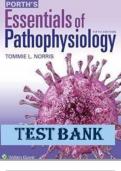
-
Porth’s Essentials Of Pathophysiology 5th Edition Test Bank with Rationales | Complete Guide A+
- Exam (elaborations) • 600 pages • 2023
-
- $24.99
- 21x sold
- + learn more
Porth’s Essentials Of Pathophysiology 5th Edition Test Bank 1. Chapter 1 Although the basic structure of the cell plasma membrane is formed by a lipid bilayer, most of the specific membrane functions are carried out by: A) Bound and transmembrane proteins B) Complex, long carbohydrate chains C) Surface antigens and hormone receptors D) A gating system of selective ion channels Ans: A Feedback: The functions of plasma membrane depend on the presence of proteins that are bound in the lipid bilay...
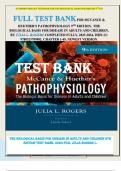
-
FULL TEST BANK For McCance & Huether’S Pathophysiology 9th Edition, THE BIOLOGICAL BASIS FOR DISEASE IN ADULTS AND CHILDREN, BY JULIA L. ROGERS ;Fully Completed, 2023-2024, ISBN-13: 9780323789882, CHAPTER 1-49, NEWEST VERSION
- Exam (elaborations) • 499 pages • 2023 Popular
- Available in package deal
-
- $16.49
- 11x sold
- + learn more
UNIT I: The Cell Chapter 01: Cellular Biology 4 Chapter 02: Altered Cellular and Tissue Biology: Environmental Agents 18 Chapter 03: The Cellular Environment: Fluids and Electrolytes, Acids and Bases 31 UNIT II: Gene and Gene Environment interaction Chapter 04: Genes and Genetic Diseases 44 Chapter 05: Genes, Environment-Lifestyle, and Common Diseases 55 Chapter 06: Epigenetics and Disease 63 UNIT III: Mechanisms of Self-defence Chapter 07: Innate Immunity: Inflammation and Wound Healin...
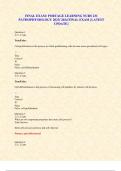
-
FINAL EXAM: PORTAGE LEARNING NURS 231 PATHOPHYSIOLOGY 2023/ 2024 FINAL EXAM {LATEST UPDATE}
- Exam (elaborations) • 18 pages • 2023
-
Available in package deal
-
- $11.49
- 6x sold
- + learn more
FINAL EXAM: PORTAGE LEARNING NURS 231 PATHOPHYSIOLOGY 2023/ 2024 FINAL EXAM {LATEST UPDATE} Question 1 2.5 / 2.5 pts True/False: Cell proliferation is the process in which proliferating cells become more specialized cell types. True Correct! False False, cell differentiation Question 2 2.5 / 2.5 pts True/False: Cell differentiation is the process of increasing cell numbers by mitotic cell division. True Correct! False False, cell prolife...

-
PORTAGE LEARNING NURS 231 PATHOPHYSIOLOGY 2023/ 2024 ALL EXAMS {LATEST UPDATE}
- Exam (elaborations) • 110 pages • 2023
-
Available in package deal
-
- $13.99
- 4x sold
- + learn more
PORTAGE LEARNING NURS 231 PATHOPHYSIOLOGY 2023/ 2024 ALL EXAMS {LATEST UPDATE} Exam 1 Question 1 1.25 / 2.5 pts Multiple Choice Which are true of the mitochondria? Select all that apply. It is involved in cellular respiration They are found far from the site of energy consumption They play a role in apoptosis They control free radicals Question 2 1.25 / 2.5 pts Which of the following are true regarding cell communication? Select all that apply. ...

-
Egan's Chapter 9 - The Respiratory System questions with correct answers
- Exam (elaborations) • 24 pages • 2023
- Available in package deal
-
- $15.49
- 2x sold
- + learn more
a. Continuous absorption of oxygen (O2) and excretion of carbon dioxide Answer What is the primary purpose of the respiratory system? a. Continuous absorption of oxygen (O2) and excretion of carbon dioxide b. Filtering to prevent allergens and microbes from reaching the lungs c. Transport oxygenated blood to the tissues d. Warm and humidify inspired gas d. Exchange of gases between the blood and the tissue Answer What is meant by "internal respiration"? a. Any gas exchange that occurs ...
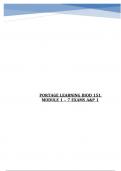
-
PORTAGE LEARNING BIOD 151 MODULE 1 – 7 EXAMS A&P 1.
- Exam (elaborations) • 81 pages • 2023
-
Available in package deal
-
- $14.99
- 7x sold
- + learn more
PORTAGE LEARNING BIOD 151 MODULE 1 – 7 EXAMS A&P 1.Module 1 1. What is the study of the structure of the human body? A. Anatomy B. Physiology C. Anabolism D. Catabolism E. Metabolism A. Anatomy 2. …......................... is an example of the organ level of organization in the human body A. Sodium B. The liver C. Mitochondria D. The skeletal system E. Epithelium 3. What is the breakdown of nutrients? A. Anatomy B. Physiology C. Anabolism D. Catabolism E. Metabolism D. ...
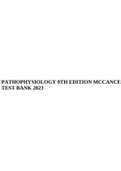
-
PATHOPHYSIOLOGY 9TH EDITION MCCANCE TEST BANK 2023.
- Exam (elaborations) • 493 pages • 2023
- Available in package deal
-
- $27.99
- 17x sold
- + learn more
PATHOPHYSIOLOGY 9TH EDITION MCCANCE TEST BANK 2023. Chapter 1: Cellular Biology MULTIPLE CHOICE 1. Which statement best describes the cellular function of metabolic absorption? a. Cells can produce proteins. c. Cells can take in and use nutrients. b. Cells can secrete digestive enzymes. d. Cells can synthesize fats. ANS: C In metabolic absorption, all cells take in and use nutrients and other substances from their surroundings. The remaining options are not inclusive in their description...

-
Exam 2: BIOS 242 / BIOS242 Fundamentals of Microbiology with Lab (Latest 2024/ 2025 Update) Questions and Verified Answers| 100% Correct| Grade A- Chamberlain
- Exam (elaborations) • 29 pages • 2024
-
Available in package deal
-
- $10.99
- 1x sold
- + learn more
Exam 2: BIOS 242 / BIOS242 Fundamentals of Microbiology with Lab (Latest 2024/ 2025 Update) Questions and Verified Answers| 100% Correct| Grade A- Chamberlain Q: which system produces the most atp? Answer: electron transport chain Q: kreb's cycle produces the majority of Answer: nadh Q: mitochondria Answer: etc Kreb's cycle Q: cell membrane Answer: kreb's cycle Etc Q: cytoplasm Answer: fermentation Glycolysis Q: larg...
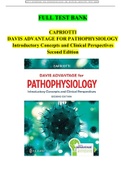
-
DAVIS ADVANTAGE FOR PATHOPHYSIOLOGY Introductory Concepts and Clinical Perspectives Second Edition CAPRIOTTI TEST BANK / Verified Answers From Publisher
- Exam (elaborations) • 476 pages • 2022
-
- $16.99
- 5x sold
- + learn more
Multiple Choice Identify the choice that best completes the statement or answers the question. 1. Which statement regarding the sodium–potassium pump is correct? 1. The cell’s plasma membrane is more soluble to sodium ions than potassium ions. 2. The concentration of sodium ions should be higher inside the cell compartment. 3. The concentration of potassium ions should be higher outside the cell compartment. 4. The active transport involves pumping out three sodium ions and pumping i...
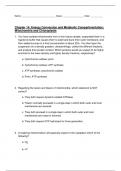
-
Chapter 14: Energy Conversion and Metabolic Compartmentation: Mitochondria and Chloroplasts TEST BANK MOLECULAR BIOLOGY OF THE CELL, 7TH EDITION BRUCE ALBERTS
- Exam (elaborations) • 27 pages • 2023
-
Available in package deal
-
- $26.98
- + learn more
Chapter 14: Energy Conversion and Metabolic Compartmentation: Mitochondria and Chloroplasts TEST BANK MOLECULAR BIOLOGY OF THE CELL, 7TH EDITION BRUCE ALBERTS
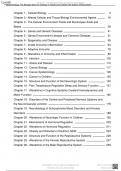
-
Pathophysiology-Testbank-pathophysiology-the-biologic-basis-for-disease-in-adults-and-children-7th-edition-by-kathryn-l.-mccance-sue-e.-huether-pathophysiology-the-biologic-basis-for-disease.
- Exam (elaborations) • 491 pages • 2023
-
- $15.99
- 2x sold
- + learn more
Pathophysiology-Testbank-pathophysiology-the-biologic-basis-for-disease-in-adults-and-children-7th-edition-by-kathryn-l.-mccance-sue-e.-huether-pathophysiology-the-biologic-basis-for-disease. Chapter 1 - Cellular Biology 3 Chapter 2 - Altered Cellular and Tissue Biology Environmental Agents 16 Chapter 3 - The Cellular Environment Fluids and Electrolytes Acids and Bases 28 Chapter 4 - Genes and Genetic Diseases 41 Chapter 5 - Genes Environment-Lifestyle and Common Diseases 51 Chapter 6 - ...

How did he do that? By selling his study resources on Stuvia. Try it yourself! Discover all about earning on Stuvia


